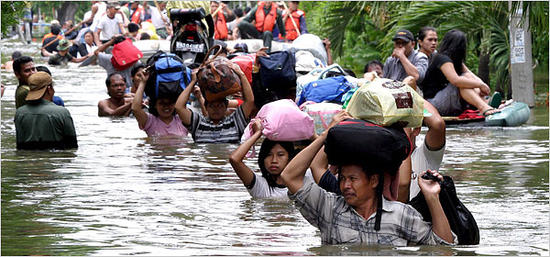
1998 summer – Atmospheric temperature went up somewhere close to 50 degree Celsius in coastal Orissa and 100s of people died of Sun Stroke. Terrible super cyclone of 1999 took over 10000 lives and shattered the economy of coastal Orissa. 2000 onwards – Coastal Orissa has been regularly visited by flood almost every year.
All the more, Coastal Orissa has become the victim of natural disasters that occurred almost every year in different forms. During last 30 years, the coastal climate has changed to a great extent and rainy season is expanded to almost half the year.
Low pressures in the Bay of Bengal have been more frequent in an abnormal pattern posing threats to the life and livelihood of people living in coastal villages and towns. ‘Such violent behaviour of the Sea is believed to be the impact of global warming that resulted in climate change across the east coast and rise in sea level’, apprehends noted geoscientist Prof. Nanda Kishore Mahalik.
At many places along the coast, Bay of Bengal has crossed miles into the human habitations grabbing villages and agricultural lands on its way. ‘This is mainly due to rise in sea level that has happened due to increase in atmospheric temperature which may have a link with global warming. The sea has in graced into land area in Paradeep, Puri, Astaranga and Gopalpur coasts of Orissa’, says environmentalist and chief wildlife warden of Orissa Bijay Ketan Pattnaik.
Worst victim of the wrath of rising sea is Satabhaya village in the northern coasts of Orissa. Standing on the edge of Bay of Bengal, Satabhaya is now struggling for its existence. Hundreds of families have left the village after loosing most of their land in the sea.
The village tube-well now stands inside the sea only as a testimony to the old village limits. Almost 90 percent of the village is washed away by the violent tidal waves. The villagers have lost most of their land in the sea. Even a low pressure with minimum intensity is enough to snatch away sleep from the people of this village.
Satabhaya was once a cluster of seven villages. Leaving Satabhaya and Kanhapur on the edge of Bay of Bengal, rest five villages of the cluster have been submerged in the sea during 1980s and 1990s.
Kanhapur Village has shifted itself thrice leaving its original location some 1 km inside Bay of Bengal. Besides Satabhaya and Kanhapur, about twenty other villages on this coast are at high risk of submergence. People of those villages have lost around sixty percent of their land in the sea.
By now, over 3000 people of the cluster have been displaced from their original villages and over 10000 people have been severely affected as most of their livelihood support components like lands and vegetation have been eaten up by the violent Bay of Bengal. Even, they are unable to fish as the sea behaviour doesn’t remain stable or predictable.
Most people who have shifted to escape the wrath of the ocean are now living as daily wage labourers or have again migrated to distant places in search of jobs.
The Sea at Astarang coast within Puri district limit has equally gone violent and crossed over two miles during last 30 years pushing the coastal villages to shift again and again. Hundreds of acres of farm land, village ponds, and vast grazing land of the villagers have gone into the sea.
The hard soil bed, remnants of mud houses and few broken household properties on the edge of the sea make the villagers of Udaykani and Chhenu remember their old village limits that are now lost in the sea.
‘Away from the sea, there was my school. The school and village roads are now inside the sea. We had our paddy lands that side. All our properties have been grabbed by the sea. Our old village was washed away by the tidal waves. We are pushed to move to the new pace that is again facing the danger of submergence. Sea water gushes into our paddy fields very often causing severe loss to us’, says Bata Pradhan of Udaykani.
The villagers of Udaykani and Chhenu have shifted at least thrice to escape the wrath of the sea. The super cyclone left these people homeless and subsequent floods destroyed their economy that is primarily based upon agriculture.
Putting his eyes fixed on the sea, Gandharva Kandei of Udaykani village says, ‘Since 1982, we have been experiencing regular floods, low pressures, and heavy rains in this coast. The super cyclone of 1999 ruined our houses in the old village. Terrified with the cyclonic storms we went to the sand embankment. To save our children we kept them in holes made in the sand. We were pulling the children out whenever there was a sliding of sand. Facing all such dangers from the sea, we are still struggling to survive.’
Chhenu and Udaykani are shifted to a little distance from their old one. But, they are still afraid of the aggression of the sea as it comes closer to their new villages also.
In 2008 July, sea crossed over 300 metres and reached the marine drive road that connects Puri and Konark – two towns of tourist importance. About 2 and half meters from the side of the road was washed away by the sea posing danger of complete breaching of the road.
It’s just a year back, tidal waves washed away half of the beach road and gushed into the town of Puri. Tourists who had visited the holy town for Jagannath Darshan and were staying in sea side hotels were shifted on emergency basis.
Known as the liveliest sandy one, Puri beach is becoming a dangerous beach as sea is expanding itself towards the township and tides are touching the beach road more often.
Rising sea level has also posed the threat of complete submergence of Asia’s largest inland lagoon Chilka. Due to heavy tidal wave on the other side of the lake, the natural sand embankment near Gabakunda was breached during last rainy season and became a 700 meter wide mouth pouring huge sea water into Chilka.
If such heavy inflow of saline water to the lake continues, the ecological pattern of the lagoon would get disturbed and the lake would have to lose its under-water treasure including variety of fish species. Inflow of sea water in large volume would also force the lake to submerge in the sea.
If it happens, the country would certainly lose a natural treasure that is known as the largest irrawady dolphin habitat and the winter resort of overseas avian guests.
The southern end of Orissan coast is also not free from the violent aggression of Bay of Bengal. The fishermen Village Podampeta is already submerged in the sea where as Garampeta village is just awaiting complete submergence. Changing behaviour of sea has closed all doors for fishing that is the main livelihood source of the coastal villages here.
The unstable and violent behaviour of sea has also caused severe damage to coastal economy as it often destroys agriculture along the coast. Once called the rice bowl of the state, whole of the coastal orissa is now affected by the climate change and disasters occure as its resultants. So, people dependent on agriculture and fishing do not see their traditional professions reliable.
Coastal erosion in the state of Orissa has not only threatened the human habitats like coastal towns and villages, the trend has also threatened all three sites where lakhs of Olive Ridley sea turtles visit every year for nesting. As renowned wildlife researcher Dr. Chandra Sekhar Kar believes, ‘the special climatic condition added with proper size sand grains contaning enough food materials for lakhs of turtles and millions of their hatchlings are the factors that attract such huge number of sea turtles for nesting’. And, Orissa is fortunate to have all three mass nesting sites in India. The sites are Gahirmatha, Devi River Mouth and Rusikulya River Mouth. But, these world famous turtle nesting sites are now in danger as sea is moving ahead.
Sea has been worshipped as the reserve of wealth. The 480 KM long coast is the ‘unique selling point (USP)’ of Orissa tourism as it attracts lakhs of tourists into the state. But the changing and violent behaviour of the sea is now posing serious threat of submergence to the total coastal zone of Orissa.
It’s high-time for the policy makers to give a serious thought to the issue. A little delay in taking control measures would allow the sea to go more violent and take many more coastal villages and towns into it causing serious livelihood problems across the coastal area.




